[ad_1]
It’s a bleak time to be a PC gamer. Nvidia’s new GeForce RTX 30-series and AMD’s new Radeon RX 6000-series graphics cards blaze new performance trails compared to last generation’s disappointing offerings—but most people have no chance of getting their hands on either, especially not at a sane price. New graphics card stock drops disappear in minutes, if not seconds, at online retailers, often at crazily high prices. Many of those cards reappear shortly thereafter on resale sites like Ebay and Craiglist for twice their suggested price, or more.
Here’s a very tangible recent example. AMD’s Radeon RX 6700 XT launched at $480 in mid-March. We said that in a sane GPU market, the price was about $100 too high for the performance offered. Sapphire said it would charge $580—an additional $100 premium—for its fantastic, custom-designed Nitro+ variant. When the Nitro+ 6700 XT actually hit the streets at Newegg, however, it cost a whopping $730 and still sold out in no time. The card is currently going for over $1,000 on Ebay. Most people have had more success claiming a vaccine shot than a new GPU this year, unbelievably enough.
So why do graphics cards cost so much right now? It’s more than just the scalpers and cryptocurrency geeks that everyone likes to blame. Let’s dig into this perfect (s***)storm.
1. Demand is wild right now
Demand for gaming hardware blew up during the pandemic, with everyone bored and stuck at home. In the early days of the lockdowns in the United States and China, Nintendo’s awesome Switch console became red-hot. Even replacement controllers and some games became hard to find.
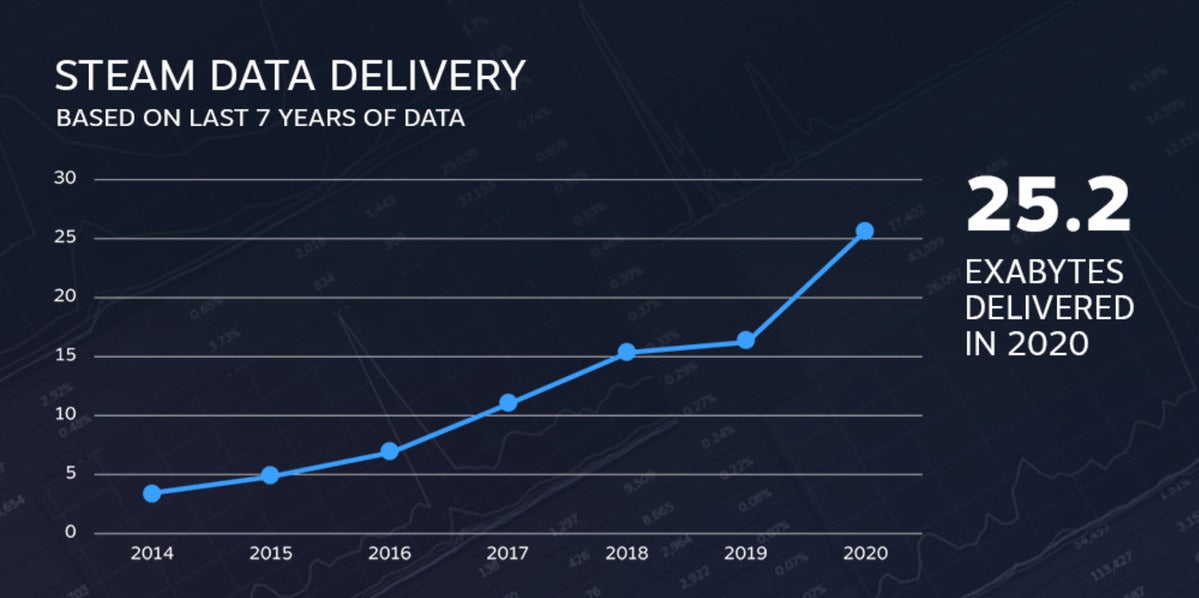 Valve
ValveSteam served up 25.2 exabytes (or 25.2 million 1 terabyte hard drives) of data in 2020.
Nintendo Switch supply became much more available as time wore on, but when the new graphics cards and next-gen PlayStation 5 and Xbox Series X consoles released last fall, they also suffered from overwhelming demand, (and still do). PC gaming boomed during the pandemic, with Steam setting fresh concurrent user milestones seemingly every other week.
People just want to play. Lots of people—even ones who weren’t gamers before.
2. Supply woes
Even though both Nvidia and AMD have said they’ve been shipping as many or more graphics cards than in prior launches, it still hasn’t been enough to keep up with the overwhelming demand, for a few different reasons.
 AMD
AMDAMD CEO Lisa Su holding a rare RDNA 2 graphics chip.
On the AMD side of things, the company launched not only the Radeon RX 6000-series last fall, but also the best-in-class Ryzen 5000 desktop and laptop processors and those next-gen consoles, which both feature AMD chips that marry Ryzen and Radeon on a single die. The company also plans on launching mobile Radeon RX 6000-series GPUs for laptops soon, too.
Every one of those products are fabricated by the TSMC foundry in Taiwan on the same 7nm process. They’re all fighting for the same 7nm chip wafers. AMD likely needed to prioritize wafers for the next-gen consoles during the crucial holiday sales period as part of their agreements with Microsoft and Sony. Ryzen CPUs—which have also been in short supply—not only best Intel’s champions for the first time in a long time, but they use much smaller dies than the large Radeon chips, so they’re likely higher on the totem pole than graphics cards until the 7nm crunch dissipates a bit. That said, TSMC doesn’t expect its “supply chain tightness” to fully relax until new fabrication facilities boot up in 2023. Sigh.
The introduction of Radeon GPUs with smaller dies (like the aforementioned Radeon RX 6700 XT) could also make it more economical for AMD to focus on churning out graphics cards. The smaller the die, the more chips you can get from a single wafer.
Beyond the AMD-specific TSMC logjam, the chip industry in general has been suffering from supply woes. Even automakers and Samsung have warned that they’re struggling to keep up with demand. We’ve heard whispers that the components used to manufacture chips—from the GDDR6 memory used in modern GPUs to the substrate material fundamentally used to construct chips—have been in short supply as well. Seemingly every industry is seeing vast demand for chips of all sorts right now.
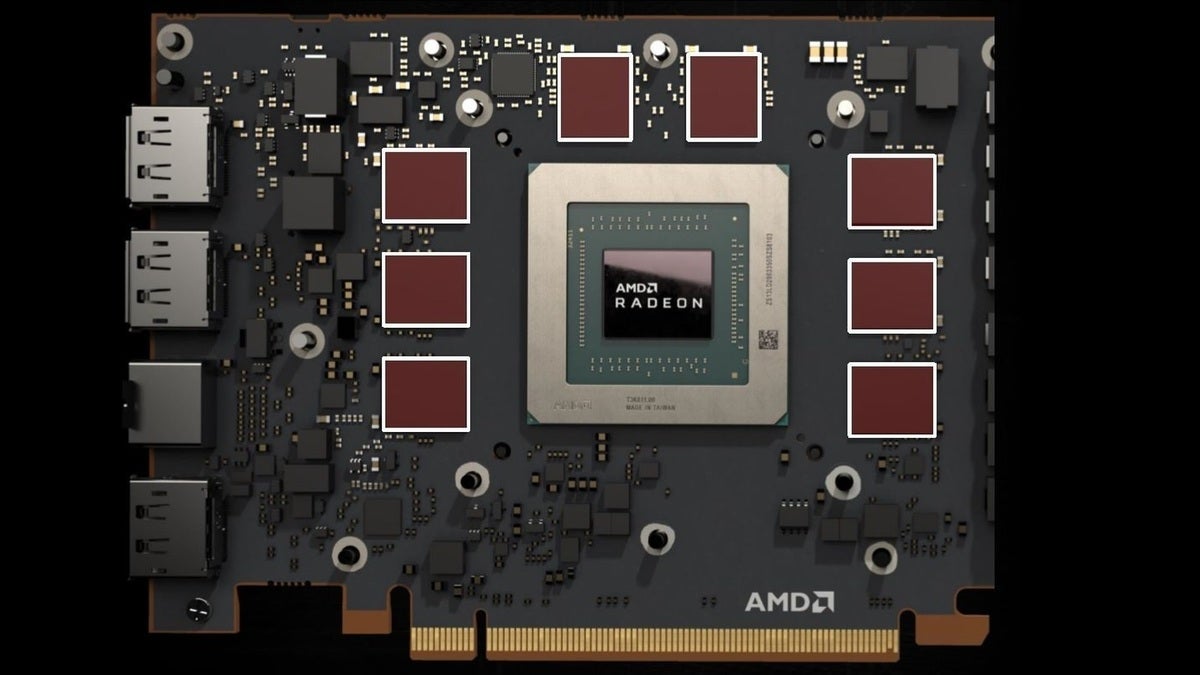 AMD
AMDThe memory chips that work in tandem around a graphics card’s GPU have also been in short supply.
“There’s other industry headwinds our whole supply chain team is looking at across the PC ecosystem,” Radeon chief Scott Herkelman told us during an exclusive interview on the Radeon RX 6700 XT’s launch day. “Some components on a graphics card—or even a motherboard for that matter—are even longer now, so you have to plan out a little bit longer.”
Nvidia agrees. “Past what we’re seeing in terms of wafers and silicon…some constraints are in substrates and components. We continue to work during the quarter on our supply and we believe…that demand will probably exceed supply in Q4 for overall gaming,” Nvidia chief financial officer Colette Kress said during a call with investors last November.
And it’s seemingly getting worse. Asus, one of the biggest PC component vendors in the world, just told investors that “The most pressing issue for GPUs right now is the shortage of Nvidia’s GPUs. There was a quarter-over-quarter decrease in shipments [in Q1]. Because of that shortage, we are seeing price hikes.” Sadly, Nvidia now says it expects demand to exceed supply for GeForce GPUs throughout 2021.
Cultural events also play a small role. “Most people don’t know Chinese New Year happened in February,” Herkelman said. Workers in overseas factories tend to take a week or more off for the holiday, which is good for them, but doesn’t help with the supply side of this ongoing shortage.
3. International shipping slows
 IBM, Maersk
IBM, MaerskShipping containers leave a port via railroad.
Supply and demand aren’t the only factors affected by the pandemic. International shipping between Asia and North America has been an absolute mess. It costs significantly more to get products into the United States now.
We spoke to several system integrators about their own difficulties acquiring PC parts right now, and they told us the following about shipping woes:
“As trade relations soured between China and the U.S., container ships that once hauled tons of goods in both directions now mostly come full, and then sit empty as exports have dried up, vendors said. Because shipping companies are reluctant to ship back empty containers unless someone pays, vendors face more surcharges and delays.
Even air freight has become an issue. While cargo planes are dedicated to shipping freight, most commercial passenger flights actually fill an estimated 5 percent to 10 percent of their capacity below the passenger compartment with freight. With commercial air travel down almost 50 percent globally, it’s difficult to receive air freight in a timely manner. Although air freight charges have dropped from the peak they reached in May, they’ve been trending up for the last two months.”
If you want to dive deeper into the vagaries of international shipping during this crisis, the New York Times published an insightful article dubbed “‘I’ve Never Seen Anything Like This’: Chaos Strikes Global Shipping.” Gizmodo’s “The Pandemic Fueled a Boom in Empty Ghost Shipping Containers Traveling the High Seas” dives into another key aspect of why international shipping costs so much right now.
Bottom line though? The current cost of international shipping adds significant costs to most PC hardware right now, several graphics cards makers and system integrators have told PCWorld.
4. One word: Scalpers
High demand and supply shortages are the perfect recipe for folks looking to flip graphics cards and make a quick buck. The second they hit the streets, the current generation of GPUs were set upon by “entrepreneurs” using bots to buy up stock faster than humans can, then selling their ill-gotten wares for a massive markup on sites like Ebay, StockX, and Craigslist.
 Brad Chacos/IDG
Brad Chacos/IDGScreenshot of Ebay results for Sapphire’s Nitro+ RX 6700 XT on March 22, 2021. This GPU has a $580 MSRP.
It’s no small matter. By the end of January, over 50,000 RTX 30-series graphics cards had been sold on Ebay and StockX.
You’ll usually find most modern GPUs going for twice their suggested retail price (or more) on those sites, and almost never find fresh stock at reputable retailers unless you’re using bots or Discord chats of your own to seek out hardware the moment it appears online.
5. Tariffs slam PC parts
Everything we’ve talked about so far would already be enough to send graphics card prices skyrocketing, but things got much worse once the calendar flipped to 2021. In January, significant new tariffs on Chinese products went into effect for many PC parts, exacerbating the crunch.
Asus served as the canary in the coal mine, informing its fans of impending price increases in early January. “Our new MSRP reflects increases in cost for components, operating costs, and logistical activities plus a continuation of import tariffs,” Asus technical marketing manager Juan Jose Guerrero III said. Prices of Asus graphics cards immediately jumped by $150 to $200 per GPU.
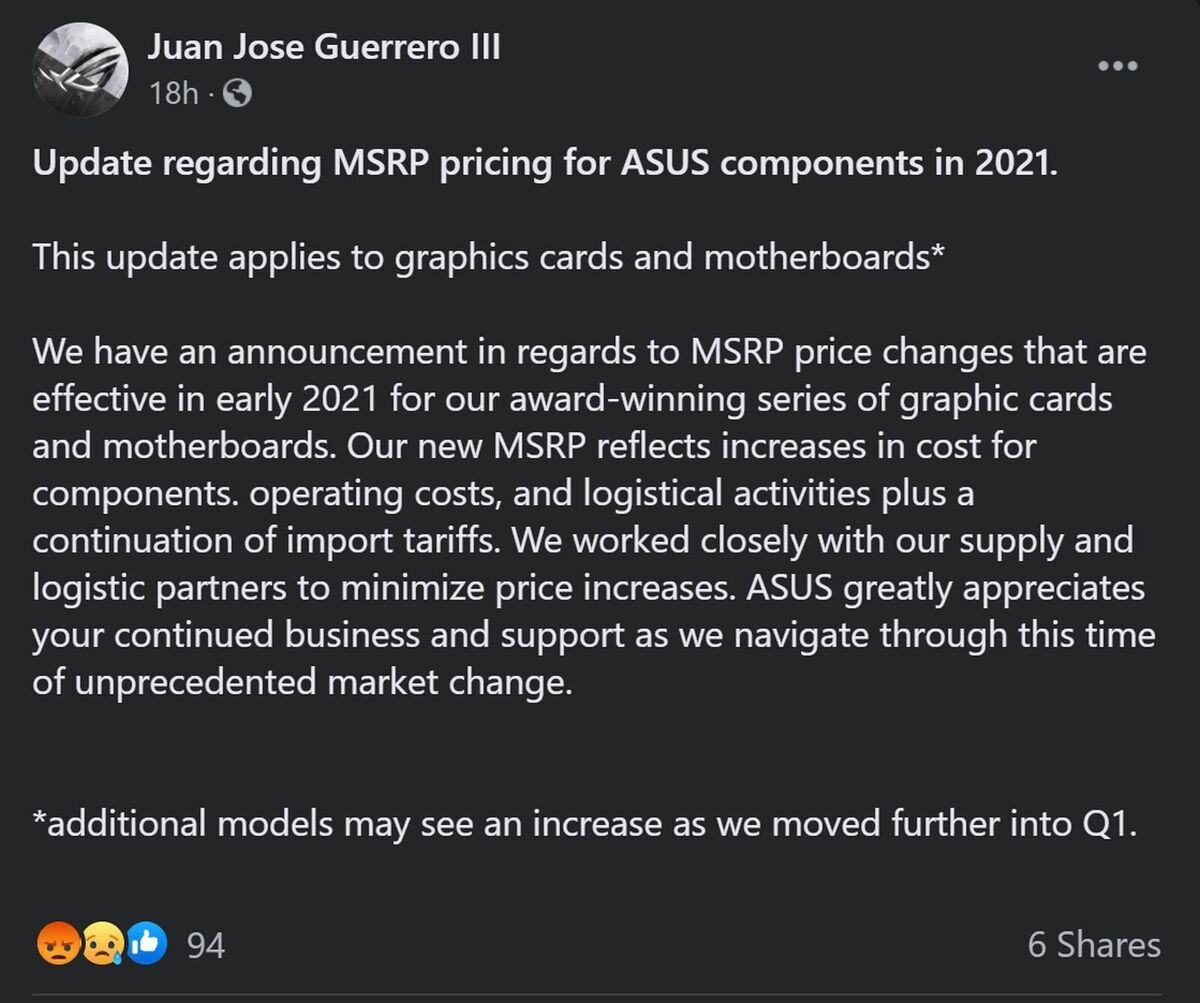 Asus
Asus Other GPU makers rolled out significant price hikes shortly after Asus. Most EVGA graphics cards went up by around $70. Zotac silently raised prices by $100 to $300 freaking dollars depending on the model. The new government policies continue to wreak havoc on GPU costs to this day.
“Right now, there are tariffs on the pricing of the product,” Herkelman said when asked about the Radeon RX 6700 XT’s seemingly high $479 price. “We have to make sure we are adhering to the legal standards we’re required to. There are mitigations we’ve put in place to make sure we can consistently hit that $479 on AMD.com. It’s all reflected in our business model of getting those products to $479 on AMD.com.”
6. Those damned cryptocoins
The situation was already untenable for PC gamers after the tariffs rolled out, but then cryptocoin speculators poured gasoline on the fire.
Whenever cryptocurrency prices boom, graphics cards become scarce, as we previously saw in 2013 and 2017. You can’t use consumer graphics cards to mine Bitcoin, the most well-known cryptocurrency, but you have to use standard GPUs to mine Ethereum. You can then trade your Ethereum for Bitcoins or cash at cryptocurrency exchanges. Well, Bitcoin’s price exploded starting in October 2020, and in January, Ethereum’s price followed. In April 2020, one Ethereum was valued at $140, per Coindesk; by October, when Bitcoin’s surge started, Ethereum hit $350 per coin. That tripled to roughly $1,000 by the beginning of January 2021, hit an apex at $1,958 in mid-February, and currently still goes for nearly $1,700.
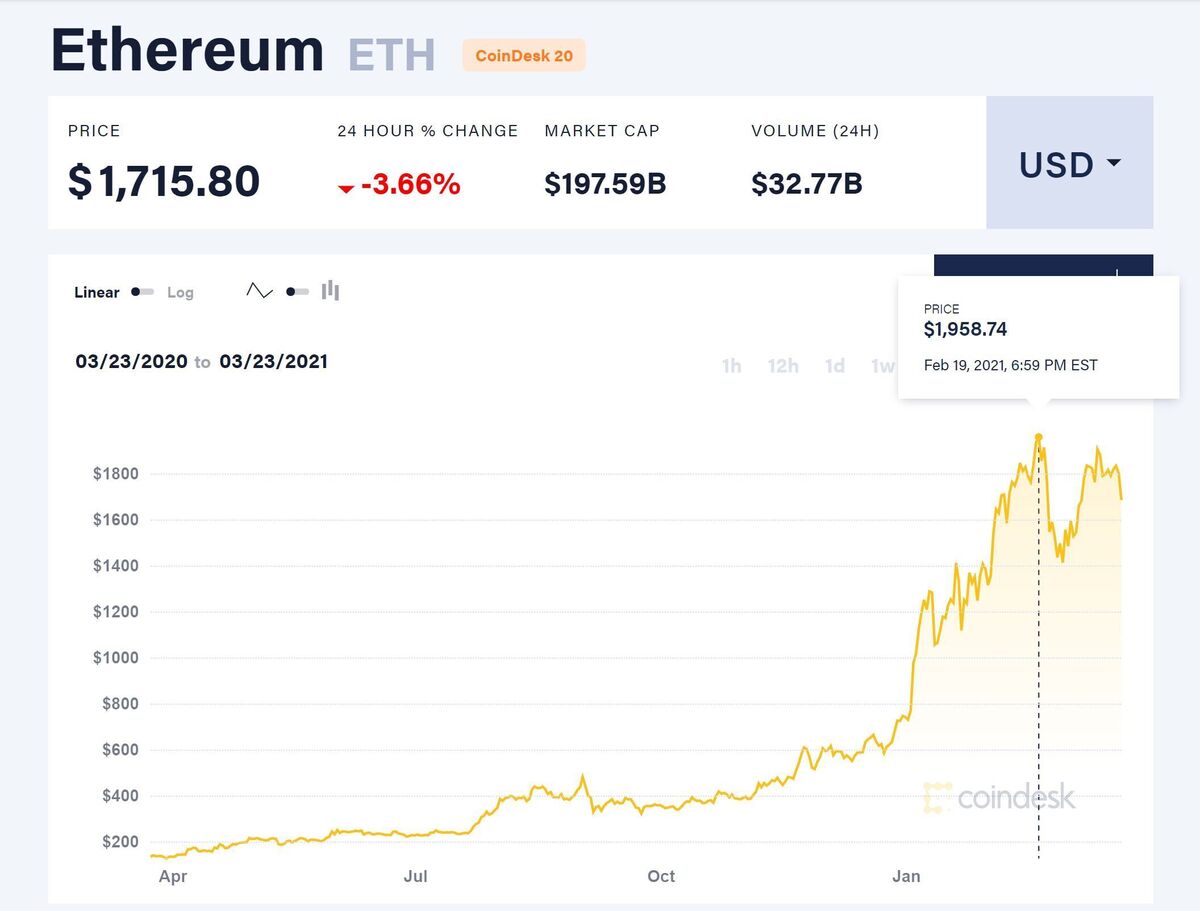 Coindesk
Coindesk Screenshot of Ethereum pricing on March 23, 2021.
When Ethereum prices go this wild, pretty much any graphics card with more than 4GB of memory can be profitable. As a result, the already-outrageous GPU shortage became even more pronounced, with even used two- or three-generation-old graphics cards selling for more than they cost new years ago. Things are so bad that Nvidia revived the RTX 2060 and four-year-old GTX 1050 Ti to help with supply. Gross.
And with Ethereum booming, this perfect s***storm finally coalesced into the GPU disaster we’re seeing today.
When will it end?
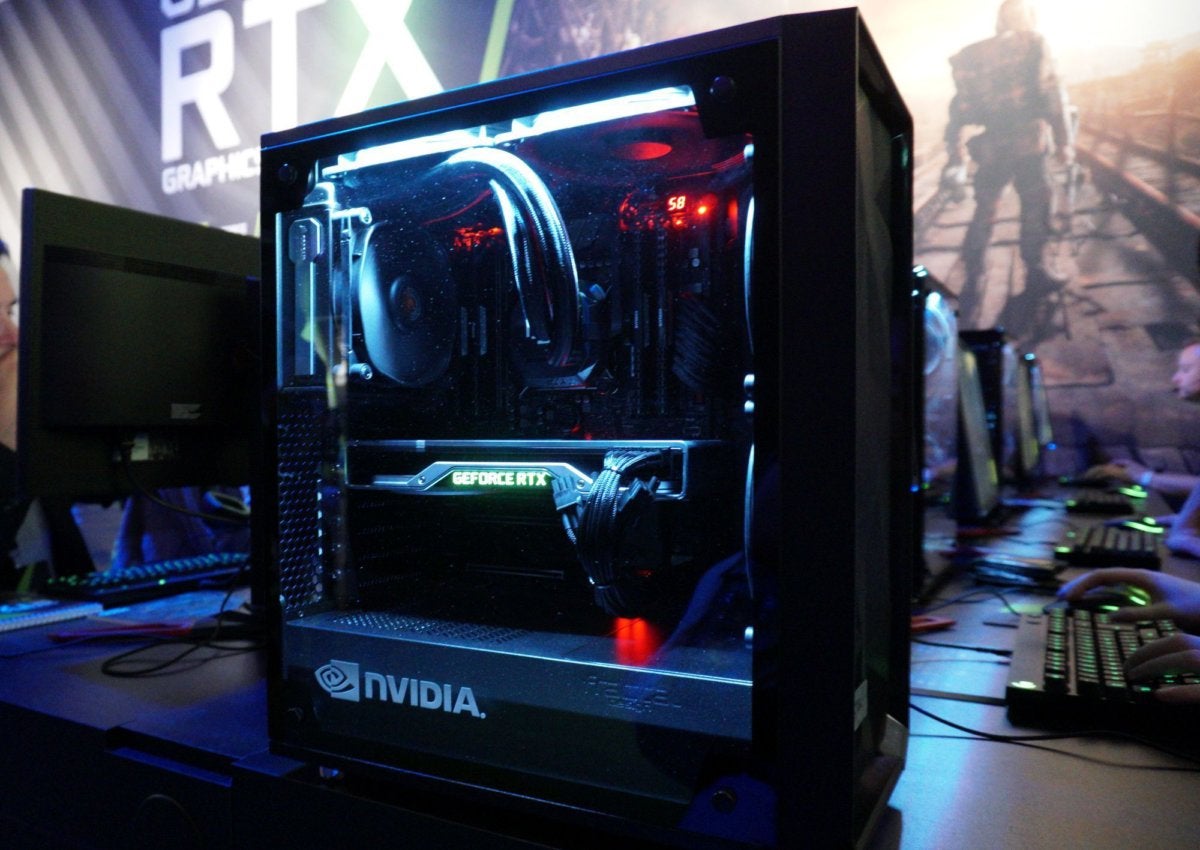 Brad Chacos/IDG
Brad Chacos/IDGIf your rig doesn’t already look like this, you may be out of luck for months.
Unfortunately, nobody knows when this madness will end. None of the underlying conditions driving today’s GPU shortage show any indications of letting up, and we’re hearing even more warnings about semiconductor shortages outside of PC components. Don’t expect relief to come for many months.
Value is in the eye of the beholder but we can’t recommend paying today’s ludicrously marked-up prices for a graphics card, or paying scalpers. If you have a working GPU, try overclocking it or tweaking the visual settings in games to help you squeeze more life out of your existing hardware.
If you don’t have a decent graphics card and need something to power your gaming during a time when everyone’s spending more time at home, there are a few options. You may have better luck finding a graphics card at a brick-and-mortar store if you don’t mind risking a visit to a physical retailer. Opting for a next-generation console is a viable alternative if you’re fine buying new games to play (or subscribing to the fantastic Xbox Game Pass Ultimate). Sadly, however, the Xbox Series X and PlayStation 5 have also been difficult to buy since they launched in late 2020. They’re easier to acquire than PC parts, though.
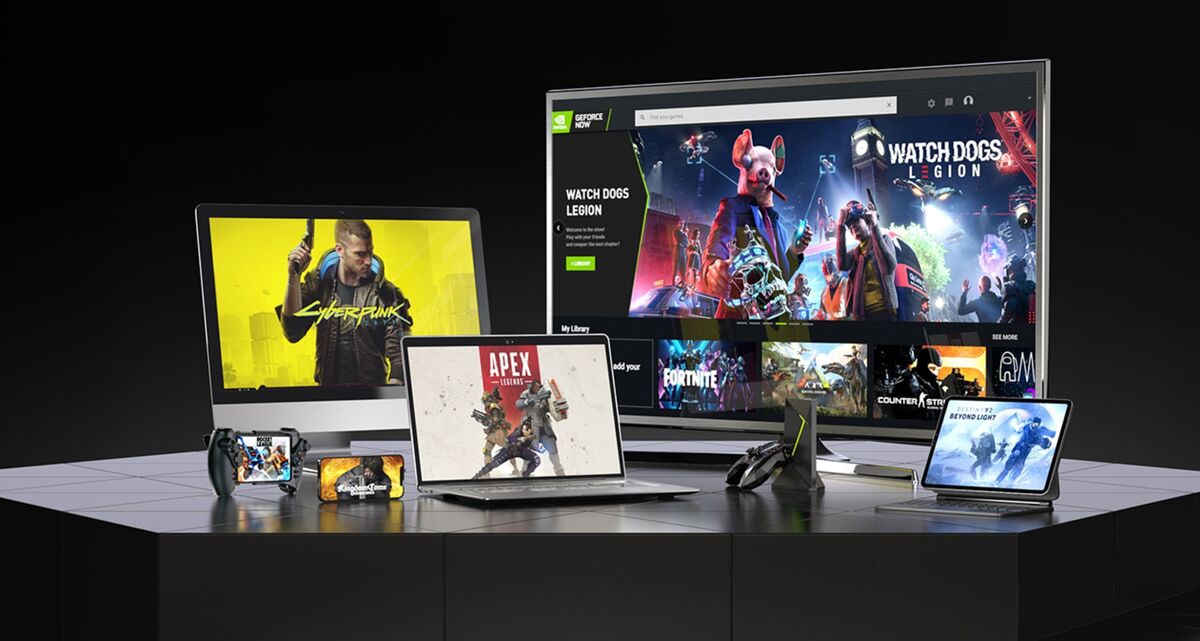 Nvidia
NvidiaNvidia’s GeForce Now lets you stream your PC games to almost any device from the cloud.
Finally, if you have a solid Internet connection, you could also stream your games from a cloud server for a solid 1080p gaming experience. We recommend Nvidia’s surprisingly good GeForce Now service, which lets you play many of the games you already own in your existing PC libraries. Here’s what you need for a good GeForce Now experience.
Google’s Stadia is also a streaming option. It functions more as a console in the cloud, with games you buy locked to the Stadia service alone. But if you preorder Resident Evil Village for Stadia for $60, Google will send you a free $100 Stadia Premiere kit with a white Stadia controller, a Chromecast Ultra that can stream the game on your TV, and a complementary one-month trial to Stadia Pro for new subscribers.
Good luck with whatever you choose. You’re going to need it.
Editor’s note: This article originally published on March 25, 2021, but was updated April 16 to note the pessimistic supply outlooks from TSMC and Nvidia in the second section.
[ad_2]
Source link